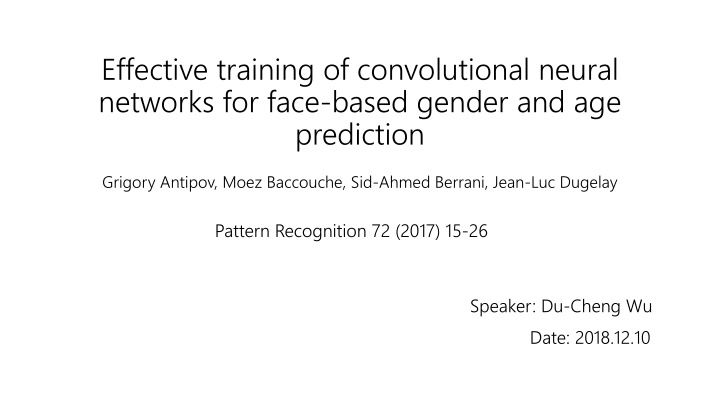
Effective Training of CNNs for Gender and Age Prediction
"Improving CNN-based approaches for gender and age prediction by analyzing target age encoding, CNN depth, pretraining, and training strategies. Designing state-of-the-art models to excel in benchmarks and challenges."
Download Presentation

Please find below an Image/Link to download the presentation.
The content on the website is provided AS IS for your information and personal use only. It may not be sold, licensed, or shared on other websites without obtaining consent from the author. If you encounter any issues during the download, it is possible that the publisher has removed the file from their server.
You are allowed to download the files provided on this website for personal or commercial use, subject to the condition that they are used lawfully. All files are the property of their respective owners.
The content on the website is provided AS IS for your information and personal use only. It may not be sold, licensed, or shared on other websites without obtaining consent from the author.
E N D
Presentation Transcript
Effective training of convolutional neural networks for face-based gender and age prediction Grigory Antipov, Moez Baccouche, Sid-Ahmed Berrani, Jean-Luc Dugelay Pattern Recognition 72 (2017) 15-26 Speaker: Du-Cheng Wu Date: 2018.12.10
Abstract(1/2) Convolutional Neural Networks (CNNs) have been proven very effective for human demographics estimation by a number of recent studies. However, the proposed solutions significantly vary in different aspects leaving many open questions on how to choose an optimal CNN architecture and which training strategy to use. In this work, we shed light on some of these questions improving the existing CNN-based approaches for gender and age prediction and providing practical hints for future studies. In particular, we analyse four important factors of the CNN training for gender recognition and age estimation: (1) the target age encoding and loss function, (2) the CNN depth, (3) the need for pretraining, and (4) the training strategy: mono-task or multi-task.
Abstract(2/2) As a result, we design the state-of-the-art gender recognition and age estimation models according to three popular benchmarks: LFW, MORPH-II and FG-NET. Moreover, our best model won the ChaLearn Apparent Age Estimation Challenge 2016 significantly outperforming the solutions of other participants.
Four important factors of CNN training for gender recognition and age estimation 1.The target age encoding and loss function 2.The CNN depth 3.The need for pretraining 4.The training strategy: mono-task or multi-task
The target age encoding and loss function ArgMax: Corresponds to the neuron with the highest activation Expected value: The age be estimated of all output activations
The need for pretraining and the training strategy: mono- task or multi-task
State-of-the-art CNNs for gender and age prediction 1. Gender Recognition and Age Estimation CNNs are firstly pretrained for Face Recognition 2. CNNs for Gender Recognition and Age Estimation are trained separaly 3. LDAE is used to encode ages for Age Estimation CNNs
Conclusion 1. training Label Distribution Age Encoding (LDAE) is more effective for AE CNN 2. AE is a more complex problem than GR, Therefore, when no pretaining is used, AE requires deeper CNN architectures than GR 3. Face Recognition pretraining is essential for training deep gender and age CNNs 4. Multi-task training for GR and AE helps only when a CNN is trained from scratch
